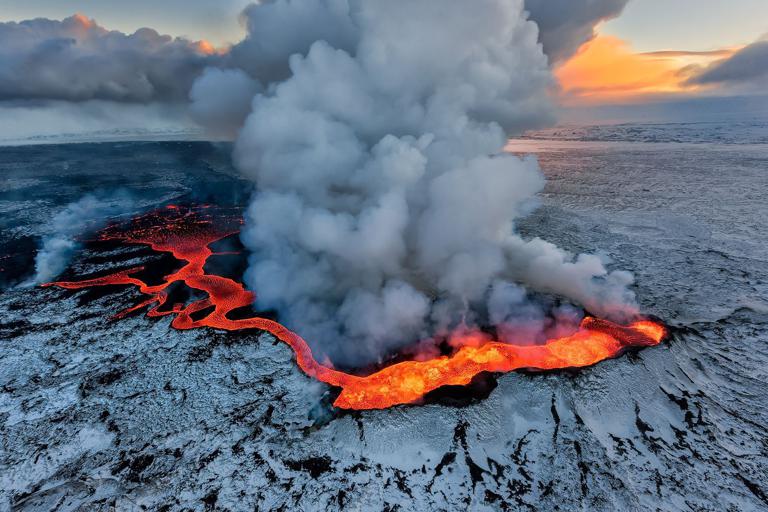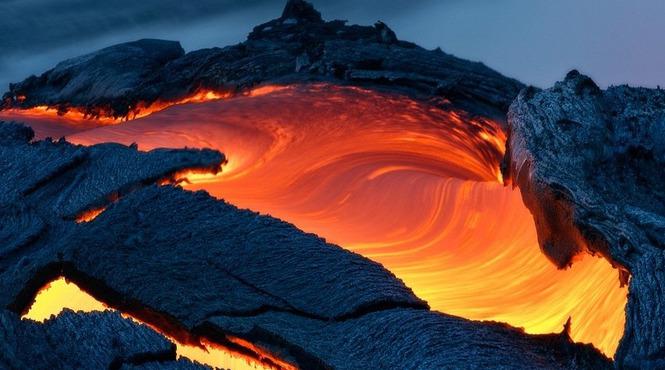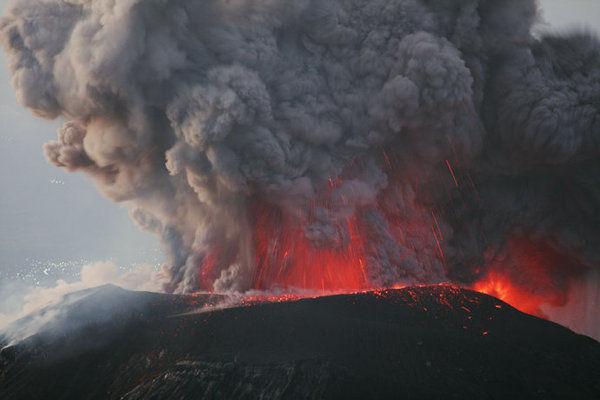Flooding eruption of basalt
Such eruptions, such as the Deccan Plateau in India and the Columbia Plateau in North America, are large faults (fissures) or groups of faults in one direction that erupt from the surface, and some erupt from narrow and long channels in an all-round way; some volcanoes erupt in a I-shaped, but are connected downward to form a wall-like passage, so they are called "fissure eruptions". Eruption is dominated by basalt, the flow direction is nearly parallel, the thickness and composition are relatively stable, the occurrence is gentle, and lava is common, often forming a lava plateau. Because great basalt fluidity, large lava ejection, rarely eruptions, seems flooding in flat terrain, overflowing everywhere, and wide distributive area, so it is also called "basalt overflowing eruption". In 1783, Laki volcano in Iceland erupted, ejecting about 12km3 of lava and 3km3 of pyroclastic material from a 25km fissure, covering an area of 565km2. Permian basalts (260000km2) in Guizhou, Yunnan and Sichuan provinces and Hannuoba (1700km2) in Hebei Province are also basalt flooding eruptions.

Hawaiian eruption
It is a hot volcano, represented by Hawaii Island, USA, which is characterized by few explosions, often spills a considerable amount of basaltic lava flow from the top crater and the hillside fissures, the magma viscosity is small and the fluidity is large, which is manifested as a relatively quiet overflow with more or less gas release. Since magma is subjected to greater static pressure and expansion of bubbles during eruption, when it reaches the surface, the lava fountain is formed, the lava fountain driven by escaping gas can reach 300 m or higher, most of the lava is basaltic lava, andesite lava, and a small amount of slag and ash. In this type of eruption, lava often overflows many times, and there are many fissures as channels, the outflow lava form a relatively flat lava dome. For example, the eruptions of Kilauea in 1924 and Mount Mauna Loa in 1975 were typical Hawaiian eruptions. This type of eruption has few casualties, but can damage farmland and villages, causing property damage.

Strombolian eruption
It comes from Italian in the early 20th century. The most typical is the Italian Stonbury volcano, located in Aegeus, Sicily, where volcanic eruptions often occur, since ancient times, it has been known as the "Lighthouse of the Mediterranean". The eruption is characterized by more or less periodic moderate-intensity eruptions, which erupt hot lava with a greater viscosity than the Hawaiian type, accompanied by white steam clouds. The lava of the crater is slightly hardened, mainly massive lava, consisting of basaltic and andesite rocks, the lava flows are thick and short, and a few are rope-shaped, from which gas escapes every half hour. This volcano prosodically erupts white-hot cinders, lapilli and volcanic bombs, milder explosion, many of the pyroclastic material fall back into the crater and ejected again, others fall on the slope formed by the cone and roll into the sea. For example, Stonbury volcano (Italy), Pallikutin volcano (Mexico), Vesuvius volcano (Italy), Avatchon volcano and Crutchev volcano (the former Soviet Union) all have the characteristics of Strombolian eruption.

Vulcanian eruption
Vulcano Island is located near Sicily Island in the Mediterranean Sea. This type of eruption is more viscous and violent than strombolian type volcanic lava with molten shaped. When no eruption occurs, a thicker consolidated crust is formed on the crater, and the gas accumulates under the consolidated crust, which makes the upper gas of the lava column tend to be saturated. When the pressure increases, a violent explosion can sometimes be enough to destroy a portion of the cone, causing the blockage to burst open, and a "bread-crust volcanic bomb" of debris and lava is erupted together with cinders, accompanied by a "cauliflower" eruption cloud containing a considerable amount of ash. When the "blockages" of the crater are erupted, lava flows flow out of the fissures on the side of the crater or cone.

Comment list ( 0 )
